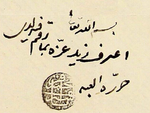This article contains wording that
promotes the subject in a subjective manner without imparting real information. (March 2018) |
Mohammad Bagher Sharif Tabatabayi | |
|---|---|
 Painted Photo From Sharif Tabatabayi | |
| Born | October 14, 1823
Isfahan, Iran |
| Died | November 5, 1901 (aged 78)
Jandagh, Iran |
| Signature | |
 | |
Mirza Muhammad Baqir Sharif Tabatabaei (Moḥammad Baqer Hamadani; 1823–1901) was an Iranian Islamic scholar.
He studied Islamic disciplines under the guidance of his father, as well as scholars such as ‘Allama Bahr al-‘Ulum, Shaykh Ja’far Kashif al-Ghita’, Agha Muhamad Baqir Hizarjaribi, and Mir ‘Abd al-Baqi Isfahani in Karbala. Following the Wahhabi attack on Karbala, he relocated to Iran, initially staying briefly at the residence of his uncle, Aqa Muhammad ‘Ali Kirmanshahi, before enrolling at the Islamic seminary of Isfahan. He devoted 13 years to teaching and writing in Isfahan, during which he authored his renowned work, Mafatih al-usul.
Biography
Mirza Muhammad Baqir was born in a village named Qehi in the vicinity of Isfahan. [1] His father, Mulla Muhammad Jafar was an admirer of Shaykh Ahmad Ahsaei Ala Maqami. After learning the basics from his father, Mirza Muhammad Baqir travelled to Isfahan to continue his education, and resided in Nimavar School where he studied different sciences for several years. Then he met one of the admirers of Haj Muhammad Karim Kermani, (who was also known as “Badr”). Since Kermani was on a pilgrimage to Imam Reza's shrine in Mashhad through Yazd, he travelled to Yazd in the hope of visiting the great man in 1261 Hijri year. Since the path was dangerous, and Kermani had to return to Kerman, Mirza Muhammad Baqir accompanied him to Kerman, and resided in Ibrahimieh School, studying Islamic theology. In a short time he had reached a level where he could teach the lessons of his grand master. After several years, the date of which is not known, Kermani sent him to the city of Naein for preaching and guidance, where he spent some years preaching and proselytizing. Mirza Muhammad Baqir immediately gained the attention and respect of the Shaykhism members of Nain, Anarak, Jandaq, Biabanak and the surrounding cities. Then he returned to Kerman, Until Kermani left for a pilgrimage to Karbala in 1283 Hijri year. When Kermani arrived in Hamedan, because of the great number of Sheikhieh adherents, and also lack of great leaders after the demise of Mullah Abdulsamad Hamedani, he appointed Mirza Muhammad Baqir as a leader in his absence, and continued his pilgrimage to Karbala. Mirza Muhammad Baqir stayed in Hamedan since his mentor had mandated it. He engaged in preaching, proselytizing and teaching Islamic principles for 32 years. He was a great leader and protector for the Sheikhieh members after the demise of his mentor, until 1315 Hijri. In Eid al-Fitr of 1315, when the riots of Hamedan occurred, he migrated to Jandaq village and stayed there for the rest of his fruitful life, teaching Islamic principles and preaching. Mirza Muhammad Baqir died on the 23rd of Sha’ban 1319, at the age of 80. After Maqrib and Isha prayer. This great man was buried in the same village, but after two years, his body was moved to Mashhad, to be laid to rest in Imam Reza's shrine, next to his Imam. He has left more than 190 manuscripts and almost 2000 sermons and teachings. [2]
Mohammad Ibrahim, the third son of Mohammad Baqir Sabzavari, migrated to Qehi village for some reasons during the Safavid period (probably during the Afghan sedition, when the murder, looting, and cruel killing of the innocent people of Esfahan, especially the scholars and the Taliban of Shi'a) Settled at the end of the western western village. The castle, which dates back a long time, is one of the village's main buildings and seven houses. These seven houses are surrounded by a long wall and seven adorned towers, seven meters high. Several generations of descendants of Mohammad Baqir Mohaqeq Sabzewari lived in this castle. Hence, they are known as castle families. Later she selected Ashrafi, Bagheri and Bagheri scholars. [2]
Education
His passion for science and learning led him to meet Hajj Mohammad Karim Kermani. Upon hearing of Hajj Mohammad Karim's planned visit from Yazd to Mashhad, he eagerly set out to meet him. However, when Hajj Mohammad Karim's visit to Mashhad was canceled, he accompanied him to Kerman and settled in Ibrahimya school. He spent many years in Anjang and Kerman, benefiting from Hajj Mohammad Karim's teachings and guidance. Later, he was sent to the Nahinites for further guidance. After several years, he returned to Kerman and resumed his studies with his teacher. Encouraged by the professor and the people of Hamedan, he returned to Hamedan and requested to publish the Ahlul-Bayt's facts. In 1288, Hajj Mohammad Karim Kermani gained popularity worldwide. Some of his students, who were aware of the knowledge and dedication of Haj Muhammad Baqir, came to Nahrzad via Hamadan until his adversaries were silenced. Finally, on Eid al-Fitr in 1315 AD, they attacked the Shaikhis of Hamedan, resulting in the death of some members of their circle. Subsequently, the Shaikhis and their families emigrated to Ray and then to a village in the desert called Jandagh. [1]
Death
Mirza Muhammad Baqir died on the night of January 23. Later, the body was transported to Mashhad, and buried near Ali ibn Musa al-Reza in the new courtyard (Azadi) room number 3, which is now located at the entrance to the Darul-e Hakmah's porch. [1]